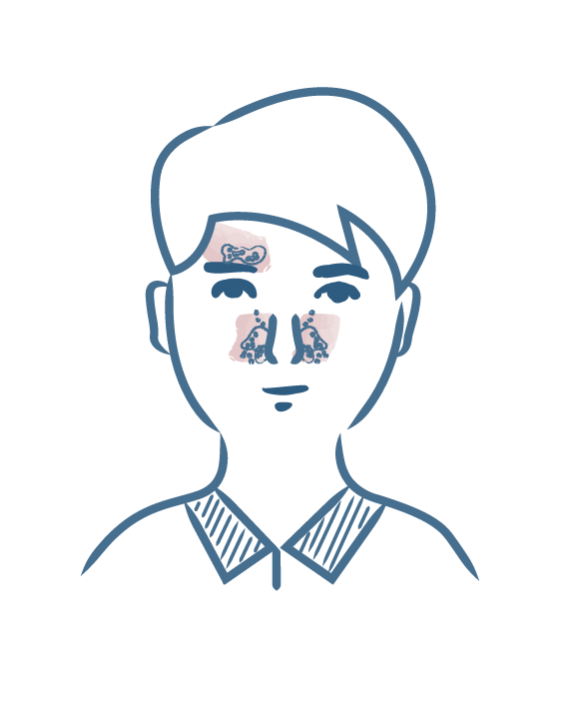
What is seborrheic dermatitis?
Seborrheic dermatitis is a common disease of the skin and scalp. It is a benign and non-serious condition, but can be embarrassing and may have a significant impact on quality of life due to its symptoms. It is characterized by red plaques covered with white or yellowish dandruff on areas where the skin and scalp are oily.
Areas affected by seborrheic dermatitis
Lesions develop in the so-called "oily" areas of the skin, where sebum secretion is greatest. The areas most affected are the scalp, the furrow between the nose and cheeks (also known as the nasolabial fold), as well as the eyebrows and the space between them, and the torso. Seborrheic dermatitis is not always limited to a single area and can affect several locations in the same patient.
Seborrheic dermatitis on the scalp
Seborrheic dermatitis on the scalp is the most common form of the disease. In 95% of cases(1) of seborrheic dermatitis, the scalp is affected, alone or in combination with other areas (face, torso, etc.).
It is characterized by widespread desquamation, with the presence of oily, yellowish, sticky dandruff on the hair, often associated with excess sebum, erythema or redness and very intense itching. However, it may also appear as simple dandruff on the scalp.
Seborrheic dermatitis on the face
Seborrheic dermatitis on the face is the most visible form of the condition. It is less common than seborrheic dermatitis of the scalp (95% of cases (1)) but the face is still affected in more than 60% of cases (1) of the condition. Scales or small plaques of skin, of varying size, are oily and sometimes crusted. Itching on the face is less intense than on the scalp.
Seborrheic dermatitis on the torso
Seborrheic dermatitis on the torso is much less frequent than seborrheic dermatitis on the face (60% of cases(1)) or on the scalp (95% of cases(1)). It represents about 30% of cases of the disease(1). It causes red, scaly plaques in the middle of the chest and, more rarely, on the back.
Differential diagnosis of seborrheic dermatitis
The visible signs of the disease are sufficient for a physician to make a diagnosis. Nevertheless, in some cases, lesions may be similar to psoriasis, eczema, or rosacea.
It is therefore sometimes difficult to differentiate between these three conditions:
- Eczema appears as red plaques with blisters (swelling containing clear fluid) and very intense itching associated with dry skin. The difference between eczema and seborrheic dermatiti s is sometimes difficult to establish. In general, the distinction between the two conditions is made on the basis of lesion location. Eczema lesions extend well beyond so-called "oily" areas and are typically located in the folds of the joints (elbows, knees, etc.).
- Psoriasis is characterized by erythematous scaly lesions. So how do you know if it’s psoriasis or seborrheic dermatitis? It isn't always easy to distinguish between the two. Psoriasis lesions are drier, thicker, better defined, more erythematous and are mostly located in areas of friction such as the elbows, knees, shins, sacrum, etc. The distinction is more difficult to make on the face, which is why the condition is referred to as sebo-psoriasis.
- Rosacea, of vascular origin, is characterized by chronic redness on the nose, cheeks and sometimes on the chin and forehead. These symptoms may be accompanied by tingling sensations. The lesions induced by rosacea may at times resemble seborrheic dermatitis lesions, but the absence of scales on the skin's surface is a distinguishing feature.
Seborrheic dermatitis in infants
When seborrheic dermatitis affects infants, the condition is called cradle cap It occurs from the first weeks of life. As with adult seborrheic dermatitis, it is caused, among other things, by a yeast of the Malassezia genus which develops in excessive quantities on some babies' skin.
Three areas may be affected:
- Scalp
- Buttocks
- Skin fold lesions
In infants, the use of specific products adapted to treat cradle cap is recommended.
(1) Misery L. Dermatite séborrhéique. EMC - AKOS Traité de Médecine. (2011), pp. 1-5
Our care routines
Irritated skin with redness and scales

